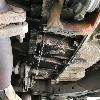mechjames
Well-Known Member
- Joined
- September 27, 2007
- Messages
- 511
- Reaction score
- 2
- City, State
- Richmond, BC
- Year, Model & Trim Level
- 1994 Explorer XLT
I have to change my transmission this weekend. It blew it's front seal, and I have a lower mileage one I picked up a little while ago.
My rear main seal has been leaking for about 3 years now, and I should have changed the main seal when I did the transmission swap 4 years ago.
Anyway the snow is here and I can't continue driving my SHO.
My parts store can get both of these fel-pro seals in:
The BS40419, which looks like a regular seal and comes with black silicone:

or the BS40647, which is PTFE rubber, and doesn't look like it needs a sealant

Which one is better? I'm leaning towards the PTFE rubber seal. Just pop it in dry, and thats it:
"Seals made with PTFE rubber have a unique “lay-down lip” contact sealing surface that can run on undersize shafts, seal minor shaft imperfections and virtually eliminate shaft wear. They must be installed dry with no pre-lubrication of the sealing lip."
Kind of similar to Ford's repair kit that they made. An improved seal, without the shim.
My rear main seal has been leaking for about 3 years now, and I should have changed the main seal when I did the transmission swap 4 years ago.
Anyway the snow is here and I can't continue driving my SHO.
My parts store can get both of these fel-pro seals in:
The BS40419, which looks like a regular seal and comes with black silicone:

or the BS40647, which is PTFE rubber, and doesn't look like it needs a sealant

Which one is better? I'm leaning towards the PTFE rubber seal. Just pop it in dry, and thats it:
"Seals made with PTFE rubber have a unique “lay-down lip” contact sealing surface that can run on undersize shafts, seal minor shaft imperfections and virtually eliminate shaft wear. They must be installed dry with no pre-lubrication of the sealing lip."
Kind of similar to Ford's repair kit that they made. An improved seal, without the shim.










